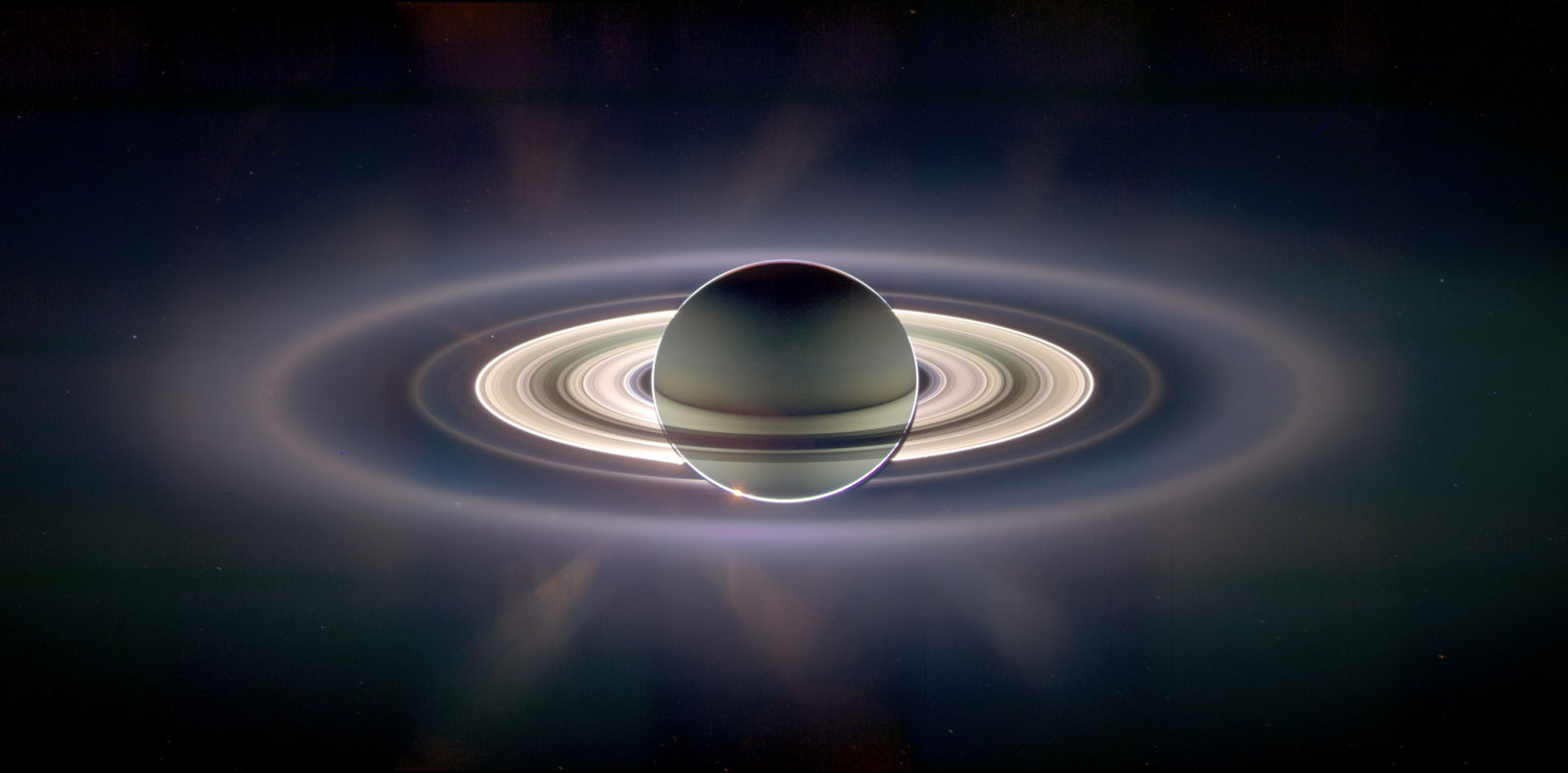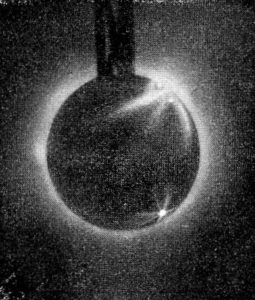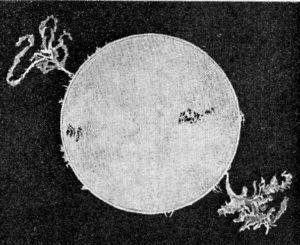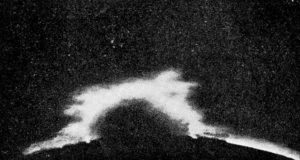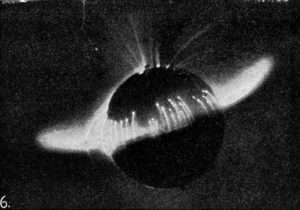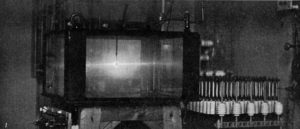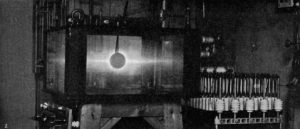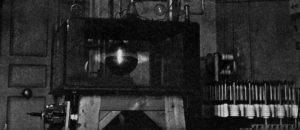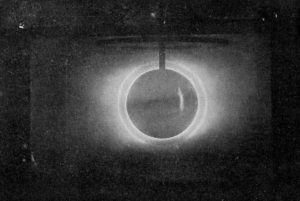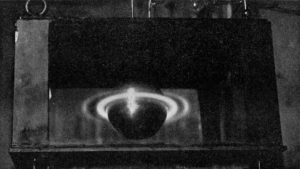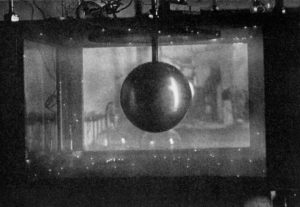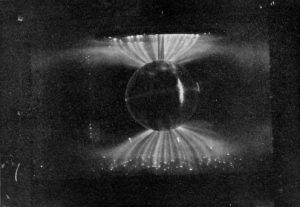Note
Extracted from:
- By Kristian_Birkeland
- Volume 1: On the Cause of Magnetic Storms and The Origin of Terrestrial Magnetism
- Section 2. Chapter VI (published 1913)
- Original full text
Chapter VI. On Possible Electric Phenomena in Solar Systems and Nebulae
[Page 661]
-
The Sun
The series of experiments that I have made with a magnetic globe as cathode in a large vacuum-box, for the purpose of studying analogies to the zodiacal light and Saturn’s ring, have led to discoveries that appear to be of great importance for the solar theory.
We have already several times had occasion to give various particulars regarding the manner in which these experiments were carried out. It is by powerful magnetisation of the magnetisable globe that the phenomenon answering to Saturn’s rings is produced. During this process, polar radiation and disruptive discharges at the equator such as that shown in fig. 247a (which happens to be a unipolar discharge) may also occur, if the current intensity of discharge is great. If the magnetisation of the globe be reduced (or the tension of the discharge increased) gradually, the luminous ring round the globe will he reduced to a minimum size, after which another equatorial ring is developed and expands rapidly (fig. 247b). It has been possible for the ring to develops in such a manner that it could easily he demonstrated by radiation on the most distant wall of my large vacuum-tube (see fig. 217). The corresponding ring would then have a diameter of 70 cm., while the diameter of the globe was 8 cm.
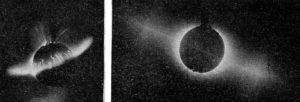
Fig 247a (left). Fig 247b (right) It is a corresponding primary ring of radiant matter about the sun that in my opinion can give an efficient explanation of the various zodiacal light-phenomena. In the above-mentioned experiments, it is seen how the rays from the polar regions bend down in a simple curve about the equatorial plane of the globe, to continue their course outwards from the globe in the vicinity of this plane. An aureole is hereby produced about the magnetic globe, with ray-structure at the poles, the whole thing strongly resembling pictures of the sun’s corona.
Rarefied gases, rendered luminous by similar discharges from the sun, would first emit a light of their own, and then diffuse that of the sun.
It is well known that the spectrum of the corona contains above all a brilliant ray of coronium λ=5304, and besides this there is a faint continuous spectrum, probably due to reflected solar light.
If the sun’s corona is of an electric origin such as we have here assumed, we might perhaps
expect to see an enormous ring of light about the sun every time the earth, during an eclipse of the[p662]sun, stood very nearly in the plane of the sun’s equator. This would have to be upon the assumption that in the spaces far from the sun, there is a gas that can become electrically luminescent, or, in an electric state, able to reflect sunlight.
It is possible to believe, however, that the sun’s chromosphere, which is a sharply-defined envelope of hydrogen, is again surrounded by an envelope of coronium, of almost limitless extent.
Analogies from the earth’s atmosphere, whose nature has been made clearer through the latest researches of HANN, HUMPHREY(1) and WEGENER, seem at any rate to indicate that the above-mentioned assumption is probable.
Wegener has recently(2) shown that there must be new fundamental layer limits in the earth’s atmosphere. Above a covering of hydrogen, which prevails from a height of 75 to 200 kilometres, a new gas is to be found, which he calls geocoronium, extending up to such heights that the steady auroral arcs, for instance, that are observed as much as 600 kilometres above the earth, would be due to electric luminescence in this gas.
(1) HUMPHREY, Distribution of Gases in the Atmosphere. Bull. of the Mount Weather Observatory, II, 2.
(2) WEGENER, Zeitschrift für anorganische Chemie, B. 75, p. 107. 1912.
- We will now pass on to experiments that in my opinion have brought about the most important discoveries in the long chain of experimental analogies to terrestrial and cosmic phenomena that I have produced. In the experiments represented in figs. 248 a-e, there are some small white patches on the globe, which are due to a kind of discharge that, under ordinary circumstances, is disruptive, and which radiates from points on the cathode. If the globe has a smooth surface and is not magnetised, the disruptive discharges come rapidly one after another, and are distributed more or less uniformly all over the globe (see a). On the other hand, if the globe is magnetised, even very slightly, the patches from which the disruptive discharges issue, arrange themselves then in two zones parallel with the magnetic equator of the globe; and the more powerfully the globe is magnetised, the nearer do they come to the equator (see b, c, d). With a constant magnetisation, the zones of patches will be found near the equator if the discharge-tension is low, but far from the equator if the tension is high.Fig. 248e shows the phenomenon seen from below.

Fig 248 (a-e) If the pressure of the gas is very small during these discharges, there issues (fig. 249, globe not magnetised) from each of the patches a narrow pencil of cathode-rays so intense that the gas is illuminated all along the pencil up to the wall of the tube. This splendid phenomenon recalls our hypothesis according to which sun-spots sometimes send out into space long pencils of cathode-rays.
SCHUSTER has recently (3) made some serious objections to the hypothesis that sun-spots emit direct, rather well-defined pencils of cathode-rays, a hypothesis which was put forward by me in 1899 and 1900, and by MOUNDER in 1904.
(3) The Origin of Magnetic Storms. Proc. of Roy. Soc., 1911.
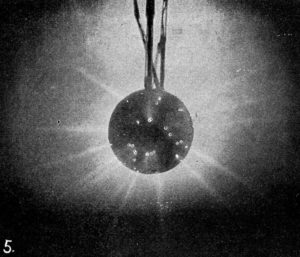
Fig 249 Schuster considers that the velocity of such cathode-particles, as they sweep past the earth, is reduced to about nine kilometres per second, and that the passage between the sun and the earth would take about a year, so that the magnetic effects of such rays could not reproduce, even roughly, the characteristic features of a magnetic disturbance.
He does, it is true, say at the conclusion of his paper:
“It is otherwise with the more refined form in which the theory has been presented by Prof. Birkeland, who, qualitatively at any rate, has shown that an agreement might be reached, if we can imagine the particles to be drawn in towards the earth by its magnetic forces, so that for the time being their motion is regulated by the position of the earth’s magnetic poles. Nevertheless, the argument from energy and from electrostatic considerations alike, has now been shown to he fatal to the theory in any form”.
I do not think, however, that Schuster’s objections have any serious bearing on my theory, if we consider the properties which the new sunbeams must be assumed to possess.
I have shown that cathode-rays from the sun, which are to strike down towards the earth in the aurora polaris zones, must have a transversal mass about m = 1.83 x 103x mo. In other words, the longitudinal mass of our particles is 6 milliard times greater than the mass of the particles upon which Schuster calculates in his energy-comments. Thus these cathode-rays will pass the earth, not with a velocity of 9 kilometres, but with a velocity very little short of that of light.
In his further development, Schuster shows that ordinary cathode-rays that issued from the sun in a well-defined, narrow pencil, would instantly be dispersed; for the electrostatic repulsion to which a particle near the limits of the pencil would be subjected from the other particles in the pencil of rays, would, according to Schuster’s calculation, impart to an electron an acceleration so great that in the very first second it would fly over a distance of astronomic magnitude.
If the calculation is applied to our rays, this acceleration would have to be divided by 3.3 millions. But even with such an acceleration, an electron would move to a great distance in the 500 seconds that a ray with the velocity of light takes in passing from the sun to the earth.
There is still, however, another point of great importance to be considered, and that is that in my theory the magnetic storms on the earth are not caused by a great, more or less cylindrical pencil of rays at a great distance from the earth, but generally a small, fine pencil of rays is drawn in in an arc down to a minimum distance of from 200 to 300 km. from the earth in the aurora polaris zones. These in-drawn pencils of rays act partly directly over the earth, partly indirectly by the earth-currents which they induce.
Let us return to our experiments. If the globe is slightly magnetised, the patches of eruption are seen to arrange themselves in zones, with long pencils issuing into space, almost as in fig. 249; only these pencils are bent by the magnetism, which is exactly analogous to what we have assumed regarding the cathode-rays issuing from the sun.
These centres of eruption for the disruptive discharges become more marked by the addition of some Leyden jars parallel to the discharge-tube; but care must be taken not to add too much capacity, as the discharge may then become oscillatory. I have generally employed about 10 to 20 milliamperes as the discharge-current for the globe of 8 centimetres diameter.
[p664]Fig.250 Fig.251 Fig.252 Fig.253 If the metallic globe surrounding the electro-magnet is not smooth, but has sharp points on its surface, for instance near the poles, the disruptive discharges would issue at these points, and it will be necessary to use a stronger magnetisation to make the patches arrange themselves in zones round the equator.
From the results obtained by SWABE, WOLF, CARRINGTON and SPOERER, we know that the sun-spots arrange themselves just in two zones between 5° and 40°N and S latitude, in such a manner that in the minimum-period of the spots, they begin to show themselves in high latitudes, and then descend until at their maximum-period they have reached a latitude of about 16° north and south. If we remember (specially that the spots are the centres of emission of very stiff cathode-rays (Ho = 3 x 106 C.G.S.), which give rise to auroras and magnetic perturbations on our earth, it would appear as if the sun-spots were the foot-points of disruptive electric discharges from the sun. The possible depressions in the enveloping photosphere by the sun-spots, which many astronomers believe to exist, can be easily explained by reference to an experiment with discharges from a quicksilver cathode in a vacuum-tube (see fig. 201. Winkelmann’s Handbuch der Physik, 4, p.530). The pressure that the discharge here exerts upon the surface is probably proportional to the energy of the discharge, which, as we shall see, must be enormous in the case of the sun.
If the pressure of the gas increases, the pencils of rays no longer issue radially from the globe, as in fig. 249, but the disruptive discharges are often seen to manifest themselves in the shape of a star with four or five arms (see fig. 250), coming from an eruptive spot, and almost following the surface of the non-magnetic globe, to meet often at a point on the globe diametrically opposite.
These discharges from opposite points (this is not clearly seen in fig. 250, however) brought to my mind a very strange picture of some enormous eruptions on the Sun (see fig. 251), reproduced from “Marvels of the Universe”. On June 26th, 1885, M. TROUVELOT saw two huge prominences, each more than three hundred and fifty thousand miles in height, rising from the sun. Flames of such dimensions are exceedingly rare; it is therefore all the more significant that they rose exactly opposite to each other from the ends of the same diameter.
It almost always happens too, in the experiment in which the cathode-globe is magnetised, that there are two or three luminous branches turning in a spiral about the eruptive spot and near the surface of the globe. These vortices move in the opposite direction to that of the hands of a watch on the hemisphere containing the magnetic north pole, and in the same direction on the opposite hemisphere.
This corresponds exactly with the results recently obtained by HALE, ELLERMAN, and Fox relative to vortices in the hydrogen filaments and calcium vapour round a sun-spot, provided it is admitted, as I have found, that the sun and the earth are inversely magnetised (Comptes Rendus, Jan. 22, 1910).
[p665]These vortices round the spots on the magnetic globe, I have not succeeded in photographing with the present arrangements. On account of the importance of all these phenomena, however, I have constructed a vacuum-vessel of 320 litres’capacity, and can employ a magnetic globe with a diameter of 24 centimetres. With this new apparatus, I have succeeded in obtaining good photographs, which will be mentioned below.
The discharges of the cathode-globe are partly continual discharges all over the surface, and partly disruptive at intervals; in the latter case they issue from the eruptive spots.
Fig. 253 shows how a branch of discharge issuing from the spots sometimes follows the magnetic lines of force in the neighbourhood of the equator, giving rise to a phenomenon which greatly resembles the black filaments on the sun, studied by HALE, ELLERMAN, FOX, EVERSHED, DESLANDRES and D’AZAMBUJA.
It will be of considerable interest to compare this experiment with some photographs of quiescent prominences on the sun. Fig. 252 is a reproduction of one of Prof. HALE’s earliest prominence photographs taken at KENWOOD’s Observatory. I have unfortunately no data to enable me to decide whether this prominence follows more or less the lines of magnetic force on the sun.
I have sought by various methods to find a value for the very singular capacity of this globe corresponding to disruptive discharges, a capacity which seems to vary perceptibly according to the conditions of the discharge. In the case of this globe (8 cm. in diameter), this capacity varies about 1/100 of a microfarad, and if I assume that the sun has a corresponding capacity C in the relation of the square of the diameters, I find that C = 3 x 1018 microfarads.
In calculating the tension of the solar discharges according to the value Ho = 3 x 106 C.G.S. (see M. Abraham, Theorie der Elektrizität, B. II, p. 83, equation (120 bis)), I find that E = 6.4 x 108 volts. The energy ½E2C = 5.9 x 1036 ergs, transformed into heat, will be sufficient to heat to 170°C. a globe of iron the size of the earth.
Sun-spots may be considered as the eruptive centres of similar disruptive discharges, and the question then immediately arises: Where shall we seek for the positive pole of these discharges, in which the spots, or that which surrounds them, represent the cathode?
There are several possible solutions to this question.
In the first place, it might be imagined that the interior of the sun formed the positive pole for enormous electric currents, while perhaps the faculae, in particular, round the spots, formed the negative poles. Or it might be imagined that the positive poles for the discharges were to be found outside the photosphere, for instance in the sun’s corona, the primary cause of the discharge being the driving away of negative ions from the outermost layers of the sun’s atmosphere in some way or other — for instance, as ARRHENIUS has assumed, by light-pressure after condensation of matter round them. Finally, it might be assumed — and this, according to the experimental analogies, seems the most probable assumption — that the sun, in relation to space, has an enormous negative electric tension of about 600 million volts.
The first assumption has the advantage of appearing to give a natural explanation of the movement of the sun-spots in various latitudes, provided that the sun’s magnetisation is the opposite to that of the earth.
[p666]In this case the origin of the sun-spots must be that the presumptive more or less insulating photospheric envelope was sometimes pierced by disruptive discharges, thus forming great electric arcs. That the tension necessary to pierce the photosphere would be very great would not be surprising, this alone being sufficient to explain the very great rigidity of the cathode-rays emitted.
The temperature of the spots should, upon this hypothesis, be very high. This, it is said, does not seem to be well confirmed by the measurements; but the temperature of a spot cannot be measured by STEFAN’S law, because under high degrees of dispersion the spectrum of the spots is not continuous; it contains nothing but lines.
It may he imagined that under the action of these violent arcs the photosphere tends to become more insulating (thicker?), and that after the maximum of the spots, the discharges cannot penetrate the photosphere as easily as after a certain cooling by radiation. The discharges then begin again in high latitudes as long as the necessary tension is at its maximum.
We do not know sufficiently how electric arcs move in gases, but it is at any rate not difficult, by magnetic forces, to attain a transversal velocity of 200 metres per second for an electric arc in air.
In order to be able to some extent to form an estimate of the manner in which the assumed electric arcs in the sun would move, we ought to know how the sun’s magnetism is distributed, or rather its cause. In my opinion it is the pencils of cathode rays appearing at indefinite intervals at the outbreak and in the development of the sun-spots, that give rise to solar magnetism by creating almost constant currents by induction in the conductive interior of the sun.
I have several times begun the calculations that should serve to verify my hypothesis, but they are not yet completed.
We know that the electric currents circulating in great spheres have a very great persistence (see LORBERG, Crelles Journal, vol. 71, 1870, and LAMB, Phil. Trans., 1883). Lamb finds that in a copper sphere of the size of the earth, the time necessary for a current to fall to 1/e of its initial value is ten million years.
The induction impulses originating in the cathode-rays emitted at intervals from the sun, seem to be able, in the course of time, to create a perceptibly constant current.
In support of my calculations, I am making experiments with a rotating sphere made of the very softest magnetisable steel. The diameter of the sphere is 70 cm. The results of these investigations will be included in the next volume.
If, to obtain a clearer conception, we assume a circular current round the centre of the sun in the plane of the equator, and with a radius equal to half the solar radius, it becomes easy to calculate the magnetic effects in different latitudes of the photosphere. In assuming spherical currents, we obtain the same degree of conformity with the currents circulating much nearer the solar surface.
The table gives Fβ divided by cos β for each ten degrees of latitude comprised between o° and 50°, where Fβ is the component of the magnetic force in an arbitrary unit, the length of the meridian. For purposes of comparison, cos2β is given, which, according to FAYE, should be perceptibly proportional to the variation of the angular diurnal motion of the spots.
β 0° 10° 20° 30° 40° 50° Fβ secβ .. .. 1.17 1.10 0.88 0.69 0.54 0.41 Cos2β .. .. 1.00 0.97 0.88 0.75 0.59 0.41 These figures have perhaps a certain interest, although, as we have said, we do not yet know well how electric arcs move in gases, under the action of magnetic forces.
The second assumption may indeed, from a physical point of view, be possible, but it is scarcely probable that any process of this nature will play a decisive part in these phenomena. It would imply
[p667]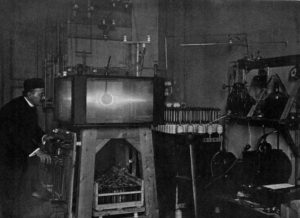
Fig.254 [p668]that the sun’s nucleus received a positive charge, of which, it must be imagined, it would to some extent gradually get rid in the interval between two outbreaks of sun-spots.
There is one circumstance that is perhaps in favour of this assumption, as also of the first, and that is the peculiar capacity that the sun, in analogy with our magnetic globe, must have. It seems as if an electric condensation must take place, so that the opposed masses of electricity are found as coatings lying close to one another.
The third assumption seems the most natural when the matter as a whole, is looked at from the point of view of the experimental analogies. It is then a question of the manner in which this negative charge on the surface of the sun has been produced in interaction with space. If to the negative mass of electricity on the external surface of the sun, there are to some extent corresponding masses of positive electricity in the interior of the sun, the first and third assumptions may be combined, which again would allow of the mysterious movements of the sun spots in the various latitudes being explained as an electromagnetic action.
It must moreover be admitted, even in the third case only, that a magnetic influence on the movement of the sun-spots was to be expected, if, as has here been done, the arrangement of the sun-spots in two parallel rows, one on each side of the equator, is assumed to be the effect of the magnetic conditions. The question then is whether it is possible, by an estimate, to show the probability of an explanation of the actual motion of the spots — in the third case as well — only as a magnetic influence. This appears to be difficult. It is true that the pencils of cathode rays that radiate from sun-spots in higher latitudes, curve rapidly down towards the equator, thereby causing the component of the magnetic force at right angles to the current-element to be comparatively much greater in the third case than assumed in the first; but whether this can cause the magnetic retrograde motion eventually produced to be more marked in the case of sun-spots in higher latitudes, than in that of spots in lower latitudes, is doubtful. The distribution of the sun’s magnetism may perhaps be rather different from what we assumed in the first case, and thus a fairly good explanation could be given. At any rate, the rotation of the sun’s body itself must be greater than the apparent rotation of any sun-spot, and this really agrees with the actual circumstances.
SPOERER’S discovery that groups of sun-spots are inclined to be drawn out in length in a direction along a parallel circle on the sun, so that the spots appearing last come to the west of those already in existence, speaks most in favour of a combination of the first and third assumptions.
The same may be said of SECCHI’s discovery with regard to the characteristic leaps in the normal rotation of a sun-spot, as the leaps usually take place in the direction of the rotation.
It is at present not easy to see how a negative tension should be continually created by the sun in relation to space.
It is of course possible to imagine that a surplus of positive ions is always being carried away from the sun or that negative ions are always being carried towards the sun, and that the negative tension is produced in this manner; and that the balance is maintained to some extent by distinct disruptive discharges, as we have presupposed.
It seems a natural thing, however, to connect the creation of this tension with the sun’s radiation of light and heat. But as MAXWELL’S electro-magnetic light theory at present stands, there is no direct opportunity of assuming that light-energy is carried over into electric energy, and that for that reason the rays of light are absorbed into space.
It is thought by several that Maxwell’s equations require a correcting term. Such a term would perhaps have influence just when there was question of a disturbance that spread into infinite space.
RIEMANN’S discoveries in the transition from infinitely small to finite amplitudes in sound-waves, might possibly afford some information.
[p669]Fig.255a Fig.255b Fig.255c [p670]The idea of an unknown transformation, in space, of radiant light and heat from the sun into another form of energy, seems to have occurred recently to other scientists.
In a paper, just published, by JULIUS, on the results from the “Netherlands Eclipse Expedition, 1912”,(1) the following conclusion is found:
- “Less than 1/1000 of the total (ultra-violet, visible, and infra-red) solar radiation proceeds from those parts of the celestial body which lie outside the photospheric level.
- “This result proves that it is impossible to maintain the theory which considers the photosphere to be a layer of incandescent clouds, whose decrease of luminosity from the centre toward the limb of the solar disk would be caused by absorption and diffusion of light in an enveloping atmosphere (“the dusky veil”). For if this theory were right, then, according to the calculations made by PICKERING, WILSON, SCHUSTER, VOGEL, SEELIGER and other astrophysicists, such an atmosphere should absorb an important fraction (¾ to ⅓) of the sun’s radiation. Now, as the fraction emitted appears to be smaller than 1/1000, and yet the atmosphere must be in a stationary condition, one would be forced to conclude that the main part of the absorbed energy is continually being dissipated through space in some absolutely unobserved form. This necessary inference not being acceptable, we must look for another interpretation of the photosphere.”
However this may be, it would be very interesting if the energy of the light and heat rays could to some extent return to the sun from space. The electric rays possibly reach as far out as the light rays, or at any rate exceedingly far, and the greater part of the energy in an electric discharge such as this may gather at the cathode, i. e. on the surface of the sun, where the electric arcs in their turn would create new heat for the radiation of more light.
In this way the age of the sun, which HELMHOLTZ and KELVIN, according to the mechanical heat theory, put at not more than 50 million years, may perhaps be put at so many hundred million years, as geologists, after researches on the earth, absolutely require. There are doubtless other sources and reservoirs of energy than those with which we are now acquainted. HELMHOLTZ was not acquainted with radium, for instance, which has of late been made use of to make the sun old enough.
- It will be immediately apparent what far-reaching consequences are here built upon our experimental analogies. There seems to be a constantly increasing appreciation of the fruitfulness of the method established by the representation of such analogies for the study of celestial phenomena.In 1860, HUGGINS made a laboratory, where numerous physical experiments were made for the interpretation of astronomical observations. The advantage of imitating the celestial phenomena in laboratory experiments, a method which forms exactly the base of the present studies, was thus known and appreciated half a century ago. The method has been followed by many, and has of late yielded marvellous results, HALE having discovered the existence of powerful magnetic forces in the solar vortices, and DESLANDRES having in this way made some very interesting experiments on the solar corona.The important phenomena, which I have discovered, of disruptive discharges from points on a magnetic cathode-globe, have especially occupied my attention.In order to investigate closely the electric analogies to the vortex-formation about the sun-spots, and to study the wonderful capacity that the globe seems to have in these disruptive discharges, I have recently resumed the whole of my experimental series with an entirely new arrangement, in which a magnetic cathode-globe of 24 cm. diameter could be employed.I will here only give a schematic description of these experiments, of which good photographic reproductions are found below.
(1) Koninklijke Akademie van Wetenschappen te Amsterdam, May 23, 1912.
Fig.256 Fig.257 Fig.258 Fig.259 Fig. 254 shows the whole arrangement with the new vacuum-box of 320 litres. Floor and ceiling are here made of 12 mm. steel plates, the pillars between are of bronze, and the sheets of plate-glass at the sides are 30 mm. in thickness.
The experiment shows the “zodiacal-light ring”. It requires little magnetising of the globe (11.3 cm. in diameter), but a great discharge-current (up to 100 milliamperes). Similar experiments are shown in figures 255, 1 and 2. In the former the magnetic globe is only 2.5 cm. in diameter; but it was easy, especially with greatly rarefied hydrogen gas in the box, to obtain a plane of rays about the globe that cut all four glass walls in brightly phosphorescent, straight stripes from 5 to 10 millimetres wide.
It is easy to prove that the plane of rays is partly formed of rays from the upper hemisphere of the cathode, that are bent down towards the equator, and rays from the lower hemisphere that are bent upwards. It will without doubt be possible to produce, with a very small cathode-globe, a ring greater in proportion to the globe than is the real zodiacal-light ring in proportion to the sun, even if the latter ring be assumed to go right outside the earth’s orbit. It is only by careful adjustment of the magnetisation of the globe, however, that the ray-masses are made to coincide, so to speak, exactly in one plane.
In general, the ray-masses from above and from below intersect one another in the plane of the equator; and it is easy to form round the circle of intersection a strongly luminous ring, floating in space round the globe, and resembling a nimbus such as painters in olden times painted round the heads of saints.
The intersecting groups of rays may often be found upon the glass walls in the form of two separate parallel phosphorescent bands of light that can be moved to and fro by slight variation in magnetisation. I believe I have seen these groups of rays twice form circles of intersection (node-
[p672]circles), when the magnetising was so arranged that the groups formed only a very small angle with one another. It would thus appear that the rays move preferably above and below the plane of the equator.
As the magnetisation is made stronger and stronger, the “node-line”in the form of a luminous circle, will approach the cathode-globe, but suddenly the balance will be disturbed, and the phenomenon will go over into a secondary ring”– which ring” — which only develops into full beauty with strong magnetisation and small discharge-current, as represented in fig. 255, 3, where the cathode-globe is 24 centimetres in diameter. Applied to the sun, our experiments would imply that we must here assume a comparatively low magnetisation, but comparatively high electric radiation.
One can imagine that among the various kinds of cathode-rays that the sun can emit, there are especially a great many that will be brought by solar magnetism to move near the plane of the sun’s magnetic equator, possibly bending alternately above and below it.
Fig. 256 shows phenomena with the large 24. cm. cathode-globe a light that resembles the sun’s corona. (1)
Applied to Saturn (fig. 257), our experiments must lead us to infer that the quantity of rays emitted by the planet was comparatively small, while the magnetisation was comparatively greater than that of the sun.
Our experiments with the large cathode-globe (see fig. 255, 3) show that if it is desired to have the ring very thin, it is better to go clown to about 1/10) milliampere; but in that case the light will also be faint. The ring looks now, however, quite as thick and distinct as with 1/10 milliampere and with one of the small cathode-globes.
Let us now simply assume that the current issuing from Saturn is as many times greater than 1/10 milliampere, as the radius of the planet is greater than that of our globe-cathode. This gives us about 50000 amperes from Saturn. Let us assume the tension to be 100 million volts. We then find
(1) As all these figures show, the apparatus has been illuminated beforehand with ordinary light, and the experiments then made and the electric light-phenomena photographed. In this way various deflexions appear in the figures that have nothing to do with the phenomena, but they will not give rise to misunderstanding.
[p673]that the radiation from Saturn would answer to 5 milliard kilowatts. This is comparatively no great amount of energy, for the lightning on our earth probably represents on an average from 4 to 5 milliard kilowatts.
This last figure I obtain in the following manner.
ARRHENIUS computes the amount of combined nitrogen falling upon the land-surface of the earth (136 million sq. km.) in the form of nitrate and nitrite of ammonia, at about 400 million tons per annum. If we take for granted that a comparatively similar amount also falls upon the sea, this gives us one part out of every three million of the nitrogen of the atmosphere as the amount that is thus combined every year, and this, we may say with practical certainty, almost exclusively by electric discharge.
Now as we know by experiment that by the most effective electric discharges 600 kg. of nitric acid is formed by the air per kilowatt-year, we can calculate that the lightning that produces nitric acid vapour in the atmosphere must at least answer to an average force-supply of 4 milliard kilowatts.
We will return to our experiments with the large cathode-globe in our 320-litre vacuum-box, as far as the previously-mentioned disruptive point-discharges are concerned, these, it will be remembered, being compared with sun-spots.
It was soon evident that the quite smooth, silver-coated, large globe of 24 centimetres’diameter, was not by any means a success when it was a question of getting these negative point-discharges upon it. The smaller globes were much better, but it was apparent that the nature of their surface had much to say in the matter. These experiments showed that with the smallest globe (2.5 cm. in diameter), it was easy to obtain, instead of the brief disruptive point-discharges, lengthy discharges from such points, only provided there was a high vacuum, and that the current-strength of the discharge was great. These pencil-discharges would suddenly change place, and arrange themselves near the equator like the earlier
[p674]spots. This possesses considerable interest, inasmuch as the sun-spots in reality represent phenomena of long duration, and not brief discharges.
With the large, silver-coated globe, it was thus very difficult to obtain point-discharges when the globe was cathode; they were pre-eminently continuous discharges from the entire surface or large portions of it.
When, however, the globe is made the anode, and the metal walls of the box, which are comparatively rough, unpolished, cast or rolled plates, are the cathode, a perfect firework-display of point-discharges takes place, in rapid succession, from the inner walls of the box. Not only were the points luminous, but long pencils of rays passed from the points (almost like a kind of lightning) in to the globe. Glowing metal particles were often torn from the points, especially from the steel plates, whence particles shot inwards along the path of the current.
In fig. 258, only the foot-points are visible, for when the anode-globe was non-magnetic, the flashes in towards the globe, though fairly powerful, were too brief and of too little intensity too be fixed upon the photographic plate with the camera used. When, on the other hand, the anode-globe was magnetised, the flashes became more intense (see fig. 259), and the points of discharge were congregated in the vicinity of the magnetic poles of the globe. The discharge-rays gathered in two zones about the poles of the anode-globe, as might be expected; but there also appeared a faint band of light, of which an indication may be seen, round the magnetic equator of the anode-globe.
In order to obtain point-discharges with my globe-cathode of 24 centimetres’diameter, I took two hemispherical shells of aluminium, and had them “sand-blasted”outside at a glass factory in the manner employed in the production of ground glass.
[p675]As soon as these shells were put on outside the silvered globe, I obtained point-discharges in great numbers; but they were not so intense as I had expected, not even when a large condenser was placed in parallel with the vacuum-tube. It was only after having exhausted my discharge-box for a long time and filled it with hydrogen, and again and again exhausted it, that these point-discharges began to be powerful.
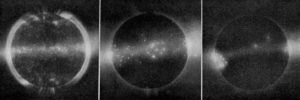
Figs. 260 a, b, and c show three photographs of discharges under varied conditions. Figs. 260 a, b, and c show three photographs of discharges under varied conditions.
The first is of an experiment with a considerable gas-pressure and very slight magnetisation of the globe. It shows an interesting radiation from the polar regions, but the point-discharges, which, it is true, are most numerous in the equatorial regions, have not separated into two zones as they usually did when the surface of the cathode was smooth.
The third photograph is of an experiment in hydrogen gas with a very high vacuum.
The phenomena here were powerful and sometimes of a distinct duration, that is to say not instantaneous discharges. Another interesting circumstance is that under the above-mentioned experimental conditions it was distinctly seen that the patches are not always single spots, but often consist of a group of spots. For instance, on the original photograph answering to Fig. 260 c, the spot above to the right is distinctly a group of 5 separate spots. We thus have here another analogy to the sun-spot conditions.
As I have frequently mentioned, I have tried in vain to photograph the vortices that sometimes develop into great beauty round the points of light in these point-discharges on the globe-cathode. I have said that the motion of these vortices is always counterclockwise on the upper hemisphere, and clockwise on the lower, supposing the globe to have been magnetised so as to have a magnetic north pole in the upper hemisphere. In the reverse case, the conditions are of course reversed.
A chance occurrence has now enabled me to produce these vortices with much greater brilliancy than before. It was as follows. The vacuum-box was exhausted by a rotary mercury-pump (Gaede pump), with a rotary oil-pump in series, both pumps being worked by small electric motors that were connected with the electric current system of the town. Sometimes, in cases of necessity, I left the pumps working while we were absent from the Institute.
On one occasion the tension was broken off, so that the motor stopped; and notwithstanding my self closing valves, the vaseline-oil from the oil-pump passed through the mercury-pump and into my large vacuum-box.
[p676]It required considerable labour to put everything into order again, but, after renewed pumping, it was found that a little oil trickled out on to the floor of the box, thus showing that it had not all been removed.
After filling the box with hydrogen and emptying it several times, the point-discharges from the globe-cathode were much more marked than before, being peculiarly intense, even without being coupled to any external capacity. The vacuum-box too, now happened to be so air-tight, that after letting it stand untouched for a week, it was impossible to detect the entrance of any foreign gas.
The most striking feature, however, of these point-discharges — which, as I have shown, have a preference for a hydrogen atmosphere — was that the frequently-mentioned branches radiating from the point of light were so intense that they could easily be photographed by the aid of a cinematographic lens. It is evident that vapours from the vaseline-oil or decomposition gases here play a part.
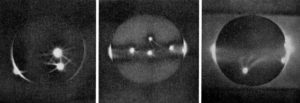
Fig.261 When the cathode-globe was not magnetised, the light-tracery that appeared round the point-discharge resembled a many-armed starfish (fig. 261 a). On rare occasions it happened that the arms of light could be followed right round the globe, where they met at a point diametrically opposite to the point of discharge. These meeting-points of the arms of light might also have the appearance of a faint point of discharge. This calls to mind TROUVELOT’s drawing, which is reproduced in fig. 251.
When the cathode-globe is magnetised with the north pole uppermost, the points of discharge move near to the magnetic equator. The arms of light about these points still exist, but they have received a twist so that the vortices created have a counter-clockwise motion on the upper hemisphere (fig. 261 b). and clockwise on the lower (fig. 261 c). With a magnetised globe also, the light from a point of discharge seemed to radiate and as it were meet in a diametrically opposite point on the globe; the light runs at any rate right round the equatorial regions every time a point-discharge occurs. It is understood from the direction of the twist, that the arms of light radiating from the points of discharge, and sometimes encompassing the globe, are a negative radiation and thus of the same kind as that which issues almost perpendicularly from the globe (see fig. 249).
If, therefore, we take for granted that the sun and the earth are oppositely magnetised, as, for other reasons, I have previously assumed (C. R., Jan. 24, 1910), then, if the analogies are correct, negative electric radiation will give rise to the vortices round sun-spots, studied by HALE. and ELLERMAN.
[p677]In some spectrographic researches on prominences on the solar disc, Fox makes the following statement (1): “Examination of all the H,, (hydrogen) plates and the record of earlier observed whirls in the calcium vapours results in assigning the direction as counter-clockwise in the northern hemisphere and clockwise in the southern. This is in agreement with the demands of FAYE’s theory.”
In analogy with our experiments, these whirls should not be due to cyclones or whirlpools, as Faye supposes, but to negative electric emission from certain centres of electric eruption. It should be remarked that as this electric emission is connected with calcium vapours and with hydrogen, it is to be expected that its velocity will not be nearly so great as that of light.
Owing to the good experimental results, which already give certain promise of the attainment of a full understanding of the two above-mentioned important phenomena — the vortex-formation and the apparent great capacity of the cathode-globe, — I have begun to construct a vacuum-vessel of i000 litres’capacity, with ceiling and floor of bronze, and glass sides of 5O mm. thickness. There have proved to be disadvantages in having the floor and ceiling magnetisable (of steel) and in their not being far enough from the polar parts of the large cathode-globe. The magnetic cathode-globe is to be 40 centimetres in diameter, for discharges of 500 milliamperes at 15 000 volts, which is the maximum delivery of my machine (see fig. 67). It will be easily understood that in addition to the purely scientific reasons for doing this, I have also a secondary object, which is to give myself the pleasure of seeing all these important experiments in the most brilliant form that it is possible for me to give them.
-
The Worlds in the Universe
From the conceptions to which our experimental analogies lead us, it is possible to form. in a natural manner, an interesting theory of the origin of the worlds. This theory differs from all earlier theories in that it assumes the existence of a universal directing force of electromagnetic origin in addition to the force of gravitation, in order to explain the formation round the sun of planets — which have almost circular orbits and are almost in the same plane — of moons and rings about the planets, and of spiral and annular nebulae. Even the newly-discovered, most distant moons of Jupiter and Saturn, with their retrograde revolution, do not place the theory in any doubtful light; on the contrary, the discovery would seem to predict that if planets are still discovered round the sun sufficiently far outside Neptune, they might also have a retrograde revolution.
The fundamental assumption with which we shall start will correspond with one of the three above-mentioned assumptions regarding the sun. For the sake of simplicity, we will assume, in conformity with case 3 above, that all suns in relation to space have an enormous negative electric tension, different for the different stars, but which, as regards order, might be somewhere about a milliard volts for stars of a class similar to our sun.
In this way electric discharges will be produced, among them being disruptive discharges from comparatively small areas (spots). One might imagine that radiation from these will give rise to circular currents in the star, parallel with the plane of the equator of the rotating central body, whereby the central body becomes magnetic.
We can then begin, for instance, to seek for an explanation of the formation of spiral nebulae.
POINCARÉ, at the conclusion of the preface to his book, ‘Hypotheses Cosmogoniques’, says:
“Un fait qui frappe tout le monde, c’est la forme spirale de certaines nébuleuses; elle se rencontre beaucoup trop souvent pour qu’on puisse penser qu’elle est due au hasard. On comprend combien est incomplète toute théorie cosmogonique qui en fait abstraction. Or aucune d’elles n’en rend compte d’une manière satisfaisante, et l’explication que j’ai donné moi-même un jour, par manière de passe-temps, ne vaux pas mieux que les autres. Nous ne pouvons done terminer que par un point d’interrogation.”
(1) Astrophys. Journ., November, T908, p. 257.
[p678]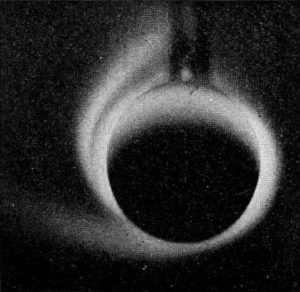
Fig 262 Now we know that of the 120 000 nebulae scattered over the sky, at least half are of a spiral form. The most remarkable thing about them is that there are very often two spirals issuing symmetrically from two diametrically opposite parts of the nebula.
We have previously seen how the continuous discharges round the magnetic cathode-globe in our experiments, could assume a shape that recalled Saturn’s ring. These continuous discharges round the globe may, however, with higher gas-pressure in the almost exhausted vessel, take the form of two spirals, curved in the plane of the equator, issuing symmetrically from two diametrically opposite points on the globe.
The accompanying figure (fig. 262) represents an experiment such as this with two such spirals. The photograph was obtained by accident, and I have seen still more interesting pictures appear, several of which I shall publish at some future time.
In the above-named work of Poincaré, a number of older cosmogonic theories, almost all of which are founded upon purely mechanical conceptions, are compared. Those of LAPLACE, LIGONDÉS and ARRHENIUS are of special interest. In the last-named, the so-called light-pressure plays a conspicuous part side by side with the force of gravitation.
In Poincaré’s work, all theories are in turn subjected to kindly criticism, with demonstration of the difficulties to which each one leads. It seems to be the celebrated old Laplace’s nebular theory that is still considered to be the strongest.
Let us now look a little more closely at the idea here put forward, namely, that the sun each day emits by electric evaporation or disintegration considerable quantities of matter in the plane of its equator which forms the part of the electric ring already mentioned, and that in earlier ages this emission of matter has been still greater.
It is not necessary to admit at first the original nebula extended to the orbit of Neptune, as the matter is radiated by electric forces outside the system at its equator. It is very probable, moreover, that the greater part of the matter thus radiated leaves the system, and in any case takes no part in the formation of the planets.
Our analysis will show that particles from the central body may be so ejected that they afterwards move in approximately circular paths near those in which the centrifugal force due to the revolution movement counterbalances the attraction of gravitation; and one could naturally believe that it is just these globules which condense and form large spheres.
Our explanation will be applicable, not only to the planets round the sun, but also to all satellites round the planets. One can imagine Saturn’s moons, and Jupiter’s, down to the outermost, newly-discovered ones that move round the planet in the opposite direction to the inner, originating in a natural manner from matter, which, under the action of an electromagnetic directing force, has been ejected from the planets in the plane of the equator.
Looked at in this way, Saturn may still be engaged in making moons by electric radiation. Mimas, almost touching the circumference of the rings, is perhaps the youngest of the satellites.
